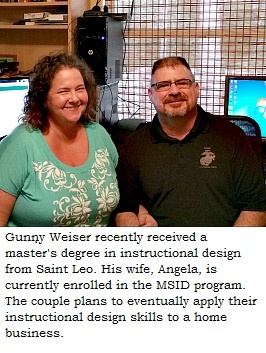Instructional Design Program Enhances Veteran's Civilian Career
An alumnus shares his experience as a student in Saint Leo's online MSID program.

An alumnus shares his experience as a student in Saint Leo's online MSID program.

 It's no surprise that the first project Tedd "Gunny" Weiser, a recent graduate of Saint Leo University's online master's in instructional design program (MSID), tackled using his new skills benefitted military veterans.
It's no surprise that the first project Tedd "Gunny" Weiser, a recent graduate of Saint Leo University's online master's in instructional design program (MSID), tackled using his new skills benefitted military veterans.
A veteran himself, Weiser retired from the U.S. Marines after 20 years of service. For a year, he acted as Saint Leo's interim director of Veteran Student Services and is now assistant director at the Gwinnett Education Center in Georgia.
With increasing numbers of retired military personnel returning to the classroom, Weiser wanted to help Saint Leo faculty and staff better understand the specific issues these veterans, particularly combat veterans, face when transitioning to civilian life. To do that, he developed an online course to provide insight into the military lifestyle and ways the Saint Leo community could be even more effective at helping student veterans achieve their educational goals.
"Prior to completing Saint Leo's MSID program, I wouldn't have known how to even begin that type of project and would still be wondering what to do with all the information I believed needed to be shared," says Weiser .
Weiser had earned a bachelor's degree in religion from Saint Leo, but hadn't really thought about a graduate degree until a vocational counselor at the Veterans Administration suggested it to him.
After enrolling in the program, however, Weiser came to realize the limitless potential of instructional design for meeting work performance and educational goals – and the mission-oriented Marine in him was drawn to its problem-solving potential.
"For me, instructional design is about the endless applications of the skills learned throughout the program," he says. "If there's anything that can be addressed or improved, instructional design can enhance learning in that area."
 Two of Weiser's favorite courses included Graphics and Design Concepts in eLearning and Production of Educational Media, a course about authoring software.
Two of Weiser's favorite courses included Graphics and Design Concepts in eLearning and Production of Educational Media, a course about authoring software.
In the graphics class, Weiser learned how to apply design principles to develop effective instructional graphics for online learning, to make presentations appear effective on any device, and to storyboard a course. Students worked in teams to complete projects, simulating a real-world work experience where each member of the team is responsible for a different aspect of the project such as: determining the appropriate educational theories and teaching methodologies to use, conducting research or designing graphics.
The authoring software class, he says, focused on how to maximize the use of current instructional technology and media to grab a person's attention and keep it.
"I learned that instructional design is an ongoing process of analysis and revising to ensure you get a finished product that fills the learning gap your client or customer is experiencing," Weiser says.
The program is cohort-based and highly collaborative. Students interact through discussion boards online and are encouraged to think critically about the skills and theories.
Weiser says he made good friends in the program by communicating regularly with fellow students through online discussion posts and attending weekly meetings with instructors through Skype, Yahoo! Messenger, Google Hangouts, and Go to Meeting.
"It's important to learn from each other in any way possible. Communication with peers and the instructor is critical to enhancing your experience in the program."
One of the aspects of the program Weiser says he appreciated most – and believes distinguishes Saint Leo's program – is that it is current and relevant. Faculty are continually looking at the latest technology and market demand and updating the curriculum accordingly, he says.
"That's so important because to be an effective instructional designer, you have to be flexible and stay current with the times."
 To gain real-world experience, students have opportunities throughout the program to practice learned skills through projects that contribute to a professional portfolio of work. The final capstone course is an applied project in which students use all the skills, attitudes, and knowledge acquired from the program to address an important problem for a non-profit organization.
To gain real-world experience, students have opportunities throughout the program to practice learned skills through projects that contribute to a professional portfolio of work. The final capstone course is an applied project in which students use all the skills, attitudes, and knowledge acquired from the program to address an important problem for a non-profit organization.
Weiser developed a training program for volunteers at his church to teach them how to run one of their regular events – their free dinner and a movie night for families – more efficiently.
Working on the project added a powerful example of his professional abilities to his portfolio, and also opened his eyes to challenges he may face in real workplace settings.
"It was hard for an old Marine who sees an objective and runs to complete it. The project taught me patience," he says. "I also learned instructional design is an ongoing process that requires lots of communication, questions and answers, analysis, and revisions."
As Weiser's wife Angela, a high school teacher, saw him go through the program, it piqued her interest. She also enrolled in the program.
The couple plans to launch a new venture—an eLearning portal that offers nondenominational, biblically based courses. The business will allow them to apply their skills to a home business when they are ready to retire.
"The opportunities that the MSID program has provided bring my family and me full-circle. I retired from the Marines at the age of 38, far too young to actually retire with so much gas left in the tank. This new skillset gives me a pathway to a second (and final) retirement plan that I can phase in over time, while still providing learning assistance to others from the comfort of my own home. It will provide an avenue toward peace of mind, as well as financial stability going forward."
What do you see yourself doing with an MSID?
Image credits: Pincasso on Shutterstock.com and Saint Leo University Communications